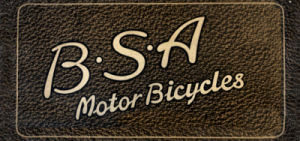

The BSA S29 was announced in time for the first full League season in 1929 and based on the Jack Parker creation.
It had been developed and produced with the "Not-so-well-off" rider in mind and came priced at £65.10s.6d.
Bore and Stroke for the machine was 3.4in x 3.8in (80mm x 98mm), the same as the 500cc "Sloper". A twin port head, open exhaust pipes and a hefty double row roller big-end bearing were specified. To prevent dust and grit being kicked into the carburettor intake, a "Protectomotor" canister air cleaner was fitted and the magneto also had a mesh screen.
The frame was completely revised to give a shorter wheelbase, and the front forks had short links and a single heavy spring to give then just a mite of controlled movement. The engine was lubricated by a tank mounted hand pump that fed oil straight into the crankcase. Clutch and Gearbox were standard BSA components although the Gearbox was a half empty shell with a direct 8.55:1 gear driving a fifty toothed rear sprocket.
Something in the region of 400 S29 DT's were sold. and many went overseas, notably to the land "Down-Under". All the machines were tested by Jack Parker himself.
The following article on Jim Gregory's BSA S29 was kindly sent in by Bryan Lambert and apart from the excellent pictures, it gives an extended insight to this early model.
In the early days of British Speedway, almost every manufacturer produced a Dirt model. Some bikes were a success, some were best pushed quietly to the back of the experimental shop.
One which did have reasonable success was BSA's offering. The prototype led to a production run of 50 or so. This may not seem like a good number, but Rudge's first attempt only ran to eight.
That very first BSA is generally held to have been put together by Jack Parker from a selection of bits and pieces. At that time he was a factory tester who had previously been a competitor in trials and turned to speedway.
That the bike is a pioneer is obvious from the handlebars. The first riders used a trailing foot style to which the bars are suited. You couldn't sit up with your foot forward in the modern style on the BSA. The links with American board racers and dirt trackers is strong. Another unusual feature of the cycle parts are the extra stays on the front forks. These were to prevent excessive sideways bending of the forks when broadsiding. They are more of a hindrance than a help - speedway machines need more flexibility than road racers.
The first motor was cobbled together from a 500 '27 sloper top end mated to a 350 bottom end carrying the mag ahead of the cases. Wet cinders must have played merry hell with it. The frame belonged to a '27 road model with little other equipment. Even the exhausts are cut off about 12 inches from the ports. The stabbing flames must have added to the spectacle of an already spectacular sport when any kind of motor vehicle was still something of a novelty.
Jim Gregory's BSA, a production model, was campaigned by Cyril Lord who rode for Coventry. Jim acquired it complete and has every reason to believe it's authentic. However, like all small batch competition machines, each bike would be modified by the rider. Jim has left it much as it was when he got it.
Asked what it's like to ride, he was very frank.
"It's a bit of a camel really. The weight's higher up than a Scott or a Douglas which doesn't help. And the ground clearance is pretty poor. You can't get it over very far without the frame scraping. Most of the other early bikes are the same. They make you admire the pioneer riders because the bikes were a real handful. They must have had some wild styles to cope. Even allowing for the early tracks having more sweeping corners and softer surfaces. I suppose though, that the bikes seem much worse when compared with modern bikes. If I'd only ever used the old ones, I wouldn't know any better, which is just like the early riders really."
From the Speedway Workshop Archive